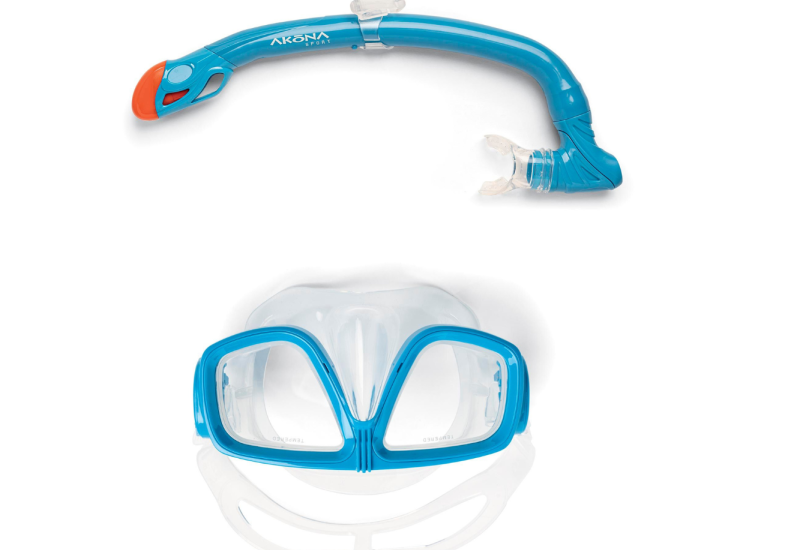Best Snorkeling Gear Review
Snorkels are not nearly as simple as they seem, so we tested 12 new models to see which features fit divers best during their time at the surface.
SNORKEL TEST PROTOCOLS
To evaluate the performance of each snorkel in open-water conditions, the ScubaLab team of test divers snorkeled off the beach at Sebastian Inlet State Park on Florida’s Atlantic Coast in seas of about 2 feet, with an onshore breeze of about 12 knots. Using waterproof test sheets and slates, divers rated each of the snorkels in seven performance categories, with 1 being poor performance and 5 being excellent. Divers also recorded comments about their experience using each snorkel and ranked their top three favorites in each category to find the best snorkeling gear.
The ergonomic test categories were:
» Security, adjustability, convenience and ruggedness of the mask attachment.
» Comfort, water seal and position of the mouthpiece.
» Effectiveness in blocking water entry.
» Effectiveness in removing water by the purge valve or blowing.
» Ability to supply sufficient air.
» Operating without excessive noise, such as gurgling or rattling.
» Weight, dimensions, stability (wobbling) or other factors affecting overall comfort.
The driest dry?
The snorkels in our test had a wide array of designs for dry valves (and spray guards, in the case of semidry purge models). Most of the dry tops used a pivoting valve mechanism that was activated by a float, but a couple had floats that actually served as the valve, traveling up to close of the tube opening. While divers noted differences in how well the tops kept out water, they depended more on the details of each design, rather than the type of mechanism.
Q: Are “dry” snorkels really dry?
A: Even some of our most skeptical test divers were pleasantly surprised at how dry some of these snorkels were, allowing almost no water in and purging what did enter without blowing or any conscious effort.
— Roger Roy, ScubaLab Director
NO “BEST” SNORKEL
Debating whether pocket, purge, dry or J-tube snorkels are best is like arguing whether dress or running shoes are better. For me, each in its place; a good dry snorkel for snorkeling and a pocket model for diving.
— Roger Roy, ScubaLab Director
Snorkels need love too
Make sure you give your snorkel the pre- and post-dive attention you give your other gear. Snorkels may seem like simple pieces of equipment, but some of the snorkels we tested had a dozen or more separate components. Start by checking all valves and floats to make sure they’re clean and moving freely, with no sand or other debris that could interfere with moving parts or valve diaphragms. Mask clips take a lot of abuse, so watch for signs of cracking or fatigue. Also, check for damage or leaks in the soft silicone of tubes and mouthpieces. If you have a roll-up or folding snorkel, it’s designed to handle being mashed up to squeeze into a case or your BC pocket during your dive. But when storing your pocket snorkel, remember to unroll it or pull it from its case and keep it opened up, which will help maintain its shape and prevent it from cracking.
Q: What factors did test divers find most important?
A:The snorkels that prompted diver comments like “The one I’ll buy” were able to keep out spray even on a windy, choppy day, easily purged any water they collected, were comfortable in the
mouth, not too noisy, and had secure mask attachments that weren’t a pain to install.
— Roger Roy, ScubaLab Director
Noises off, please
Divers were turned off by excessive noise, usually from gurgling in the reservoir/purge valve but also whistling or rasping in the tube. Even if it didn't affect a snorkel's dryness, too much noise was annoying.
For more SCUBALAB testing visit: /tags/scubalab
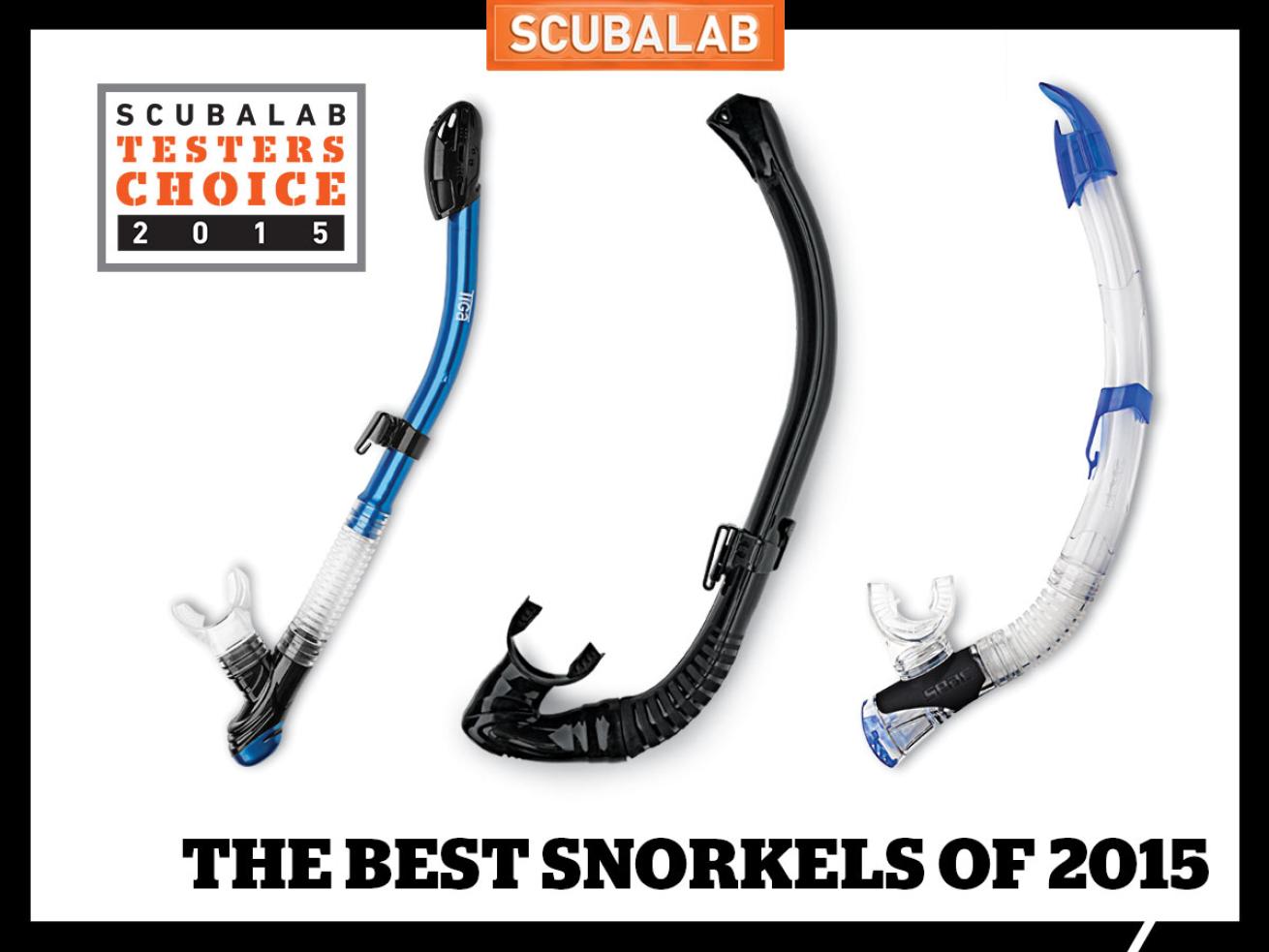
John WhittleScubaLab Snorkel Test
We tested 12 of the latest-model snorkels, from roll-ups to full-on dry models.
Sherwood Scuba Tiga Dry Snorkel
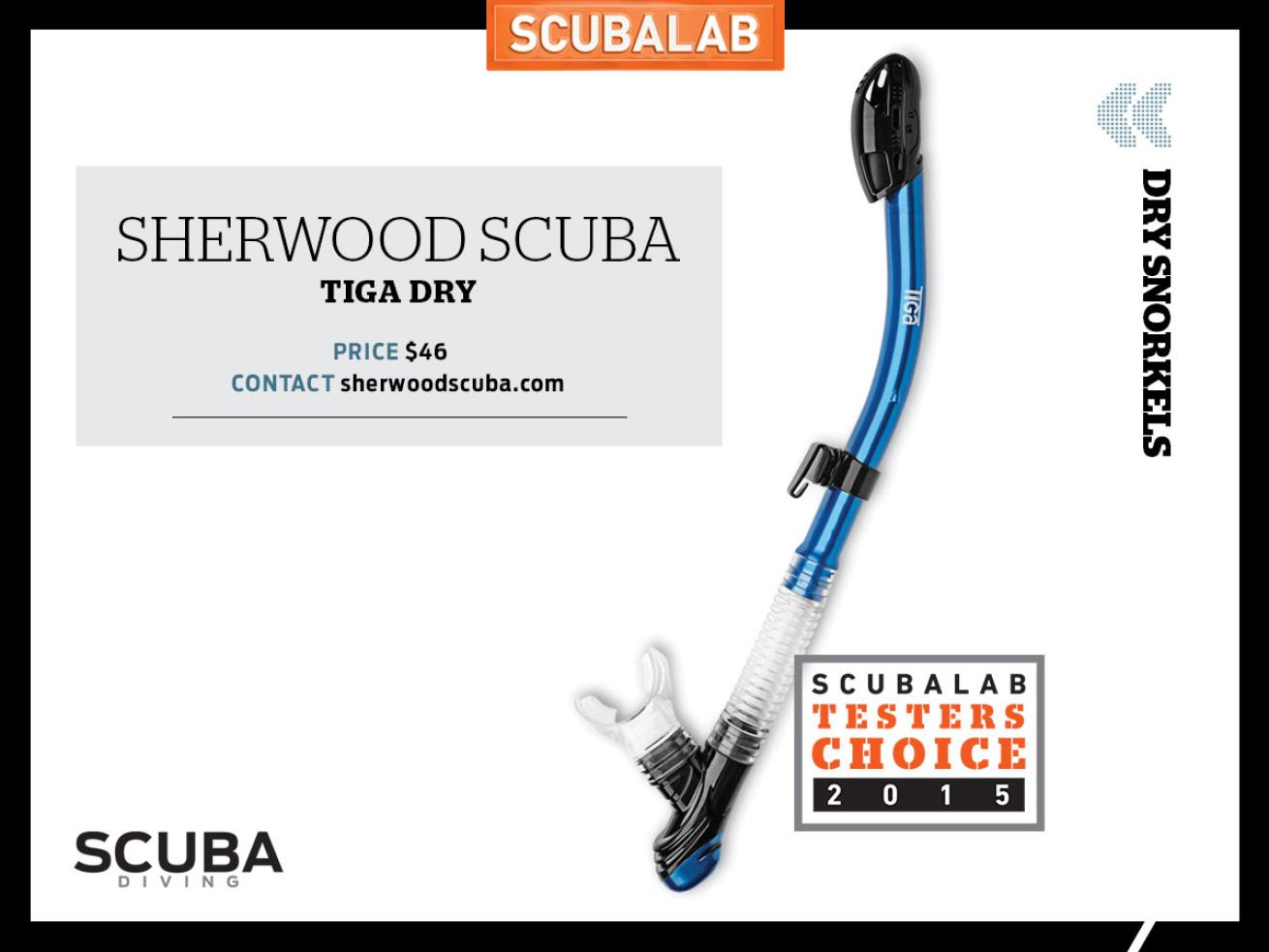
John WhittleSherwood Scuba Tiga Dry Snorkel
Among tough competition, subtle things make a piece of gear stand out, and so it was with the Tiga Dry. Its purge valve is the largest in our test, nearly an inch in diameter, and sits at the bottom of a bulblike reservoir that’s offset from the mouthpiece tube, which made it effortless to clear and bone dry. The top dry valve was rated one of the best at blocking water entry, even in a windy chop. The snorkel was stable at a fast swim, thanks to the oval upper tube and the streamlining cover and fins around the sizable purge reservoir. The mask attachment was rated about average for security but among the top for ease of operation, with an intuitive push-button release. Those details helped the Tiga Dry earn top scores in five of our seven evaluation criteria and make its way onto more divers’ top-three favorites lists than any other snorkel. The Tiga Dry is our Testers Choice in this category.
Body Glove Majorca Snorkel

John WhittleBody Glove Majorca Snorkel
The Majorca’s dry-top mechanism uses an inverted U-shaped intake with a float valve that travels upward to block airflow. It closes instantly when you submerge, and despite the extra turn in the intake, it doesn’t ham- per air delivery or make the dry top’s cross section noticeably larger or draggier than the more common hinged valves. The upper tube on the Majorca has a pronounced oval cross section that helps reduces drag, and divers reported no wobble, even when swimming hard, despite the fact that it was one of the longest snorkels in our test. The purge valve is nearly horizontal when in use, and effective enough that divers rated it very good for clearing. The Majorca tied the top score for overall comfort in our test — impressive performance, considering it was the least expensive snorkel in the category, earning it a Best Buy win.
Cressi Alpha Ultra Dry Snorkel
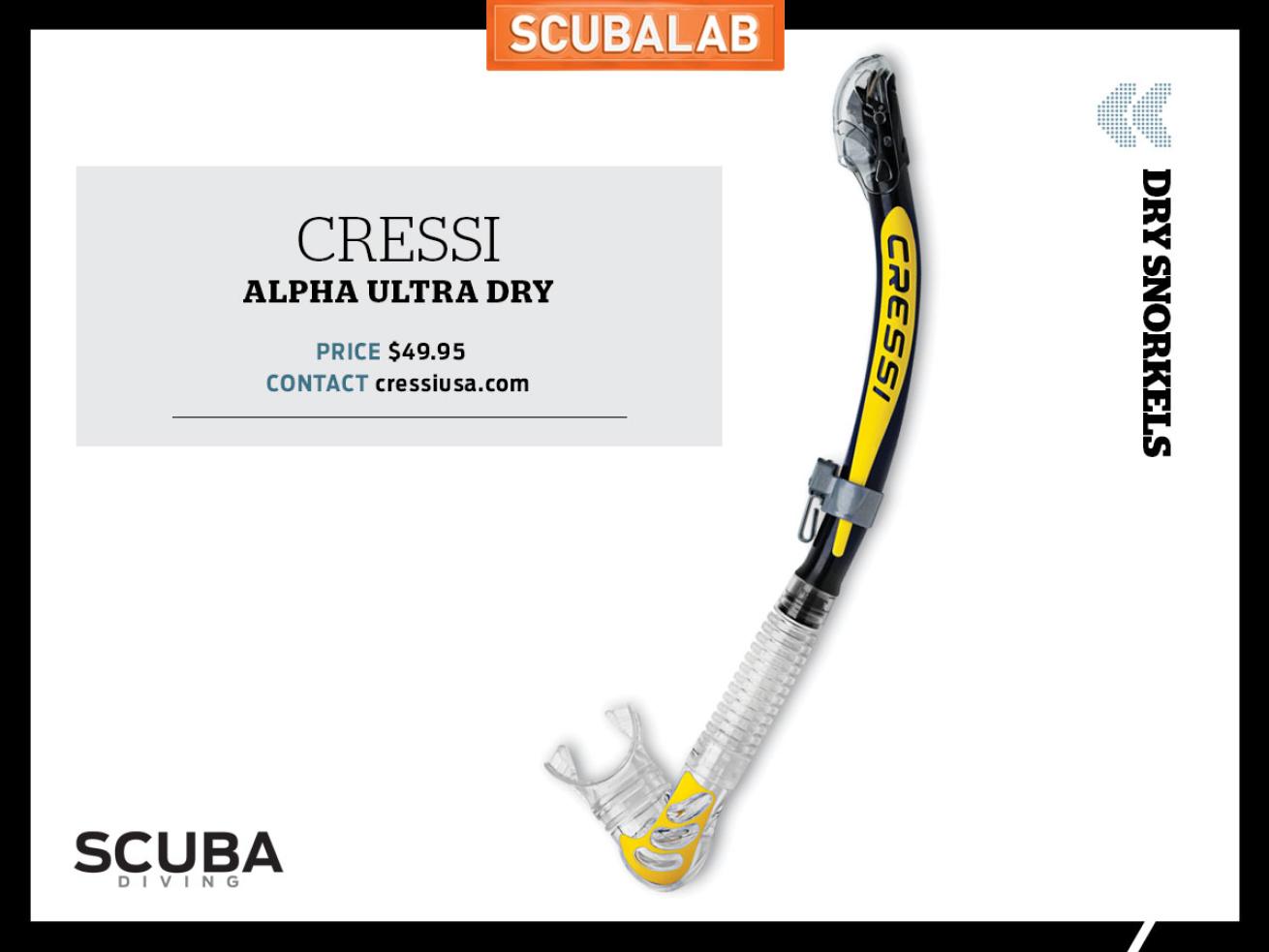
John WhittleCressi Alpha Ultra Dry Snorkel
This snorkel illustrates just how much engineering goes into what might seem a simple piece of gear, with clear housings that let you see all the internal workings of the pivoting valve in the dry top and purge valve at the bottom. The purge reservoir sometimes gurgles a bit, but water doesn’t enter the mouthpiece, and the downward-facing valve drains quickly. Divers rated the snorkel very good for air delivery, staying dry and clearing. The upper tube is oblong in cross section, giving a large volume without excessive drag. The two-part mask attachment has a push-button release that’s simple once you get the hang of it; the mask clip has a long hook and small opening that make it finicky to attach but secure once on the mask strap. As with several snorkels in this test, divers split on the mouthpiece, with some finding it a bit large and others rating it just right.
IST Sports Dry Snorkel (SN203)
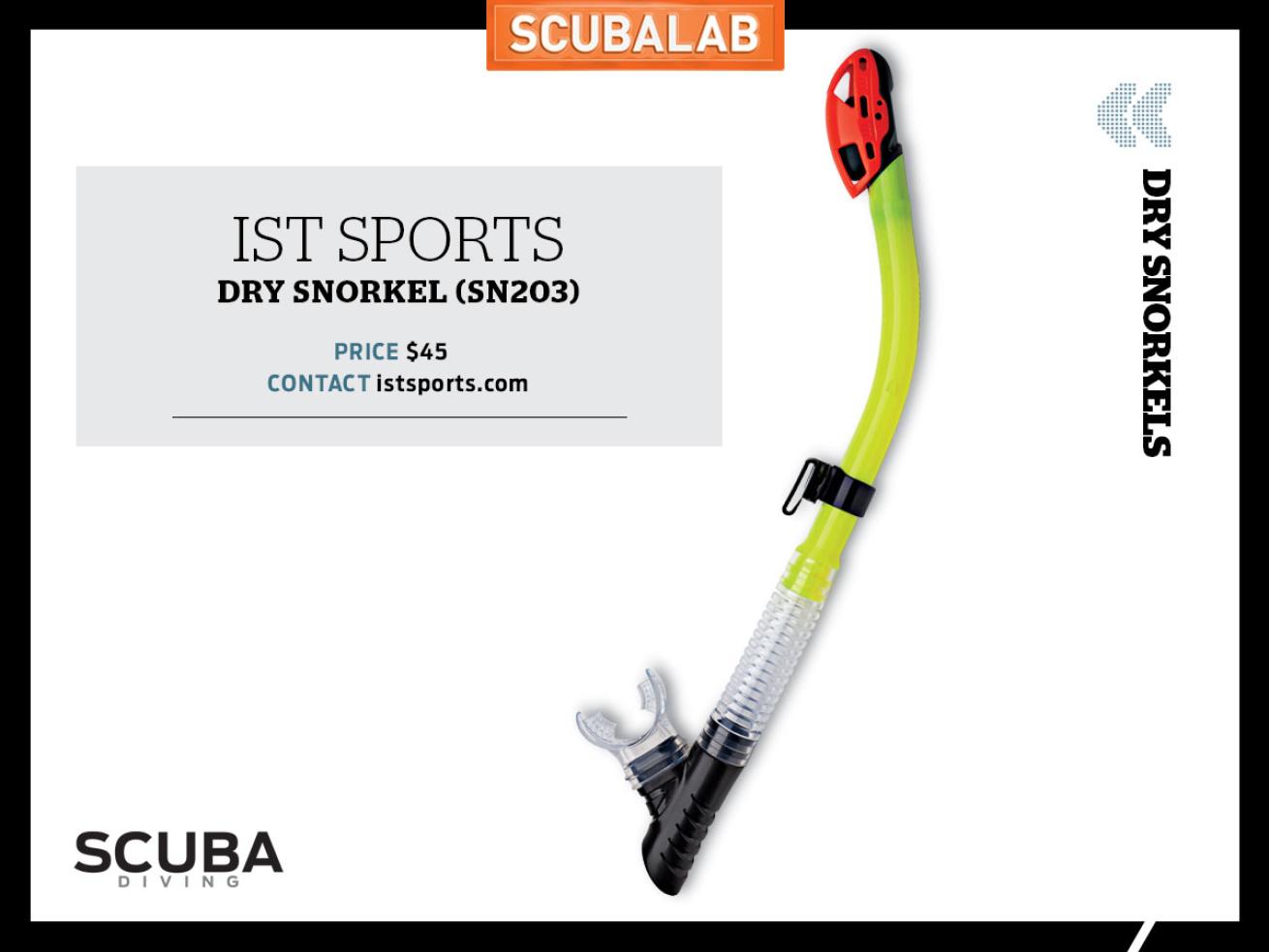
John WhittleIST Sports Dry Snorkel (SN203)
The orange dry top and yellow tube on this model from IST are so bright they practically glow. But under the eye-grabbing color scheme, this snorkel has some solid design elements that earned one of the highest combined scores in the test. The top valve is smooth in operation and well-shielded from spray, and the horizontal purge at the bottom performed very well, tying the top scores for staying dry and clearing. The upper tube has an oval, low-drag shape and is sized for ample air delivery. Divers rated the snorkel very good for mouthpiece comfort and for the operation of the mask attachment, which has a push-button release that’s easy to operate and a strap hook that is easy to install and quite secure. Some divers noted a little noise when breathing hard, but overall it was rated very good for noise, air delivery and overall comfort.
Mares Ergo Dry Snorkel
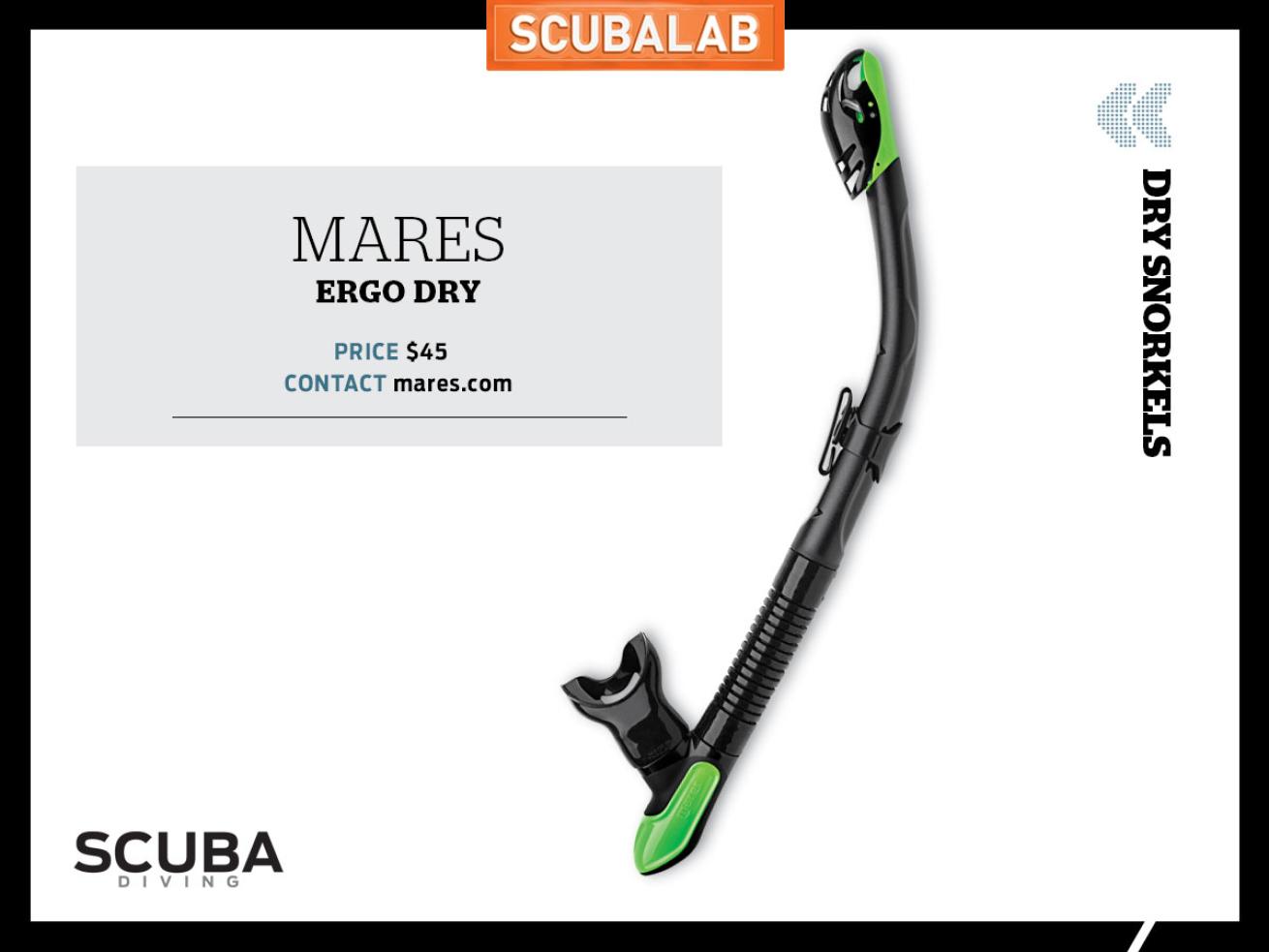
John WhittleMares Ergo Dry Snorkel
The aptly named Ergo Dry snorkel has a top valve that operates smoothly and efficiently, keeping water out whether dipping below the surface or churning along on the top of the surf. Its angled reservoir and downward-facing purge valve quickly trapped and eliminated what little water did find its way inside. Divers gave top scores to the mask attachment, which is unlikely to pop off by accident and has a strap hook that’s simple to install and big enough to accommodate even the widest strap. Our test divers rated the Ergo Dry very good for clearing, staying dry, air delivery and noise, as well as for overall comfort. In fact the only area where the Ergo Dry’s score fell below very good was the mouthpiece, which has a solid bite strip across the top that helps retain its shape but some divers found a bit too bulky for their liking.
Oceanic Ultra Dry Snorkel
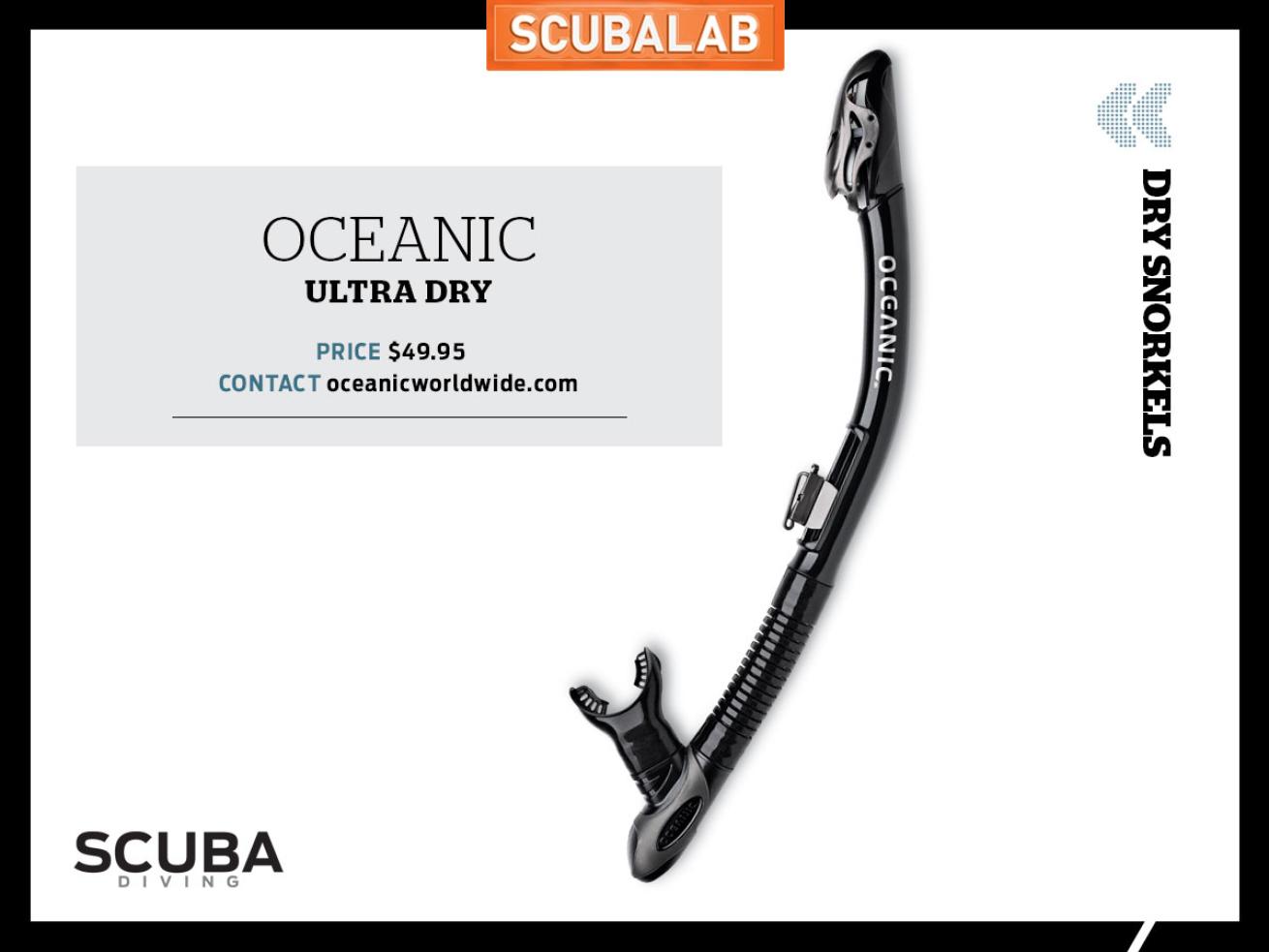
John WhittleOceanic Ultra Dry Snorkel
One of the longer snorkels in our test, the Ultra Dry has a relatively large housing around its dry-top valve — perhaps why divers rated it very good at keeping out water. The purge, with a diagonal reservoir that slopes to a bottom-facing valve, makes for easy clearing without noticeable water remaining in the bilge. The large, round upper tube supplies plenty of air, earning a very good score for air delivery, but also cuts a wide cross section; that and the Ultra Dry’s beefy size probably account for why a few divers noticed a bit of drag and wobble when swimming hard. The mask attachment was loved by divers who got the trick of turning it 90 degrees and pushing the button release while sliding to the side, and unloved by those who didn’t quite get it. In any case it’s easy to slip onto a strap, holds securely and slides on a nicely designed track.
Tilos Ari Dry Snorkel
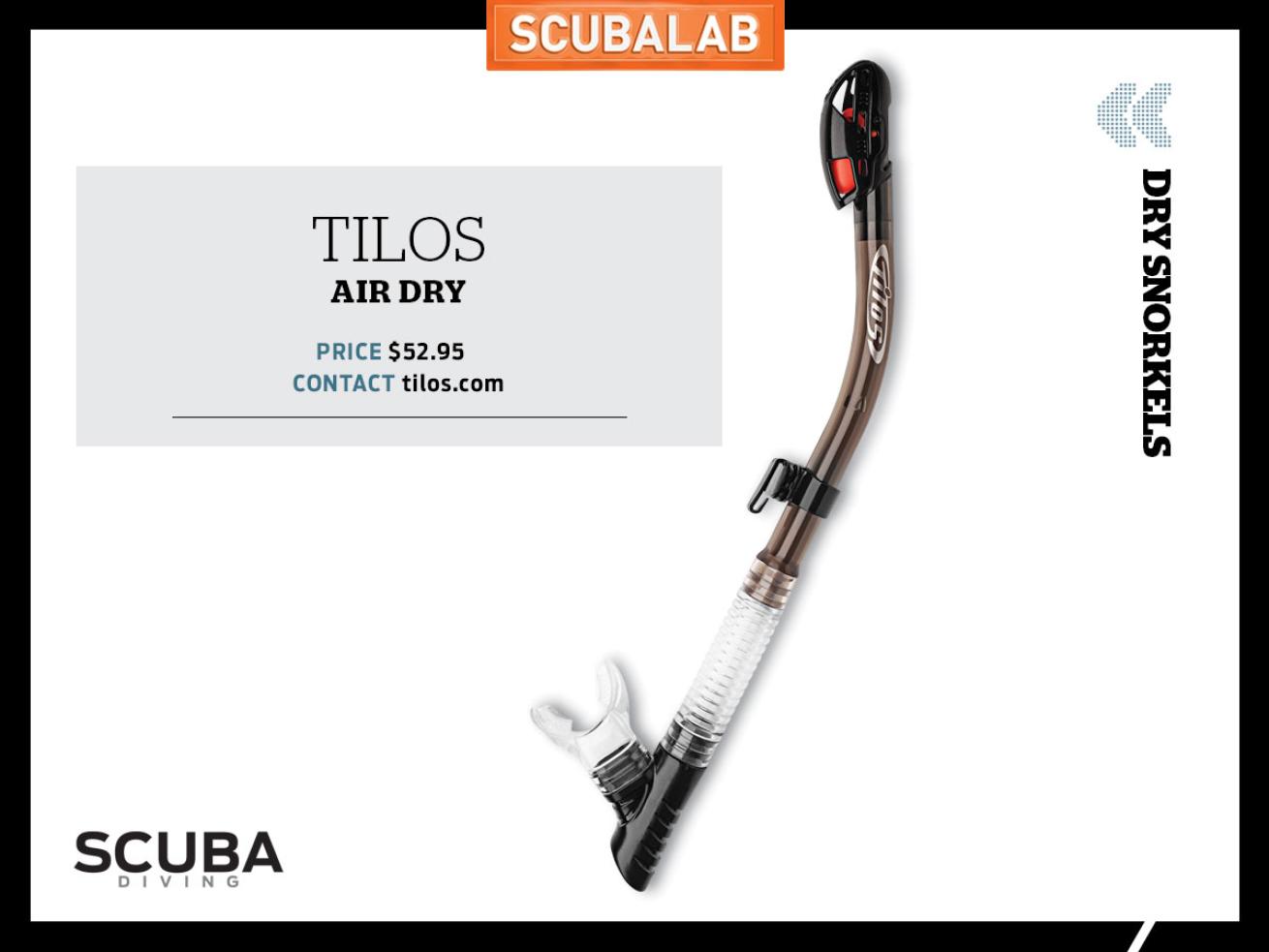
John WhittleTilos Ari Dry Snorkel
The top-end mechanism of the Ari Dry, like several other models in this test, uses a float that pushes up a pivoting valve to seal the intake opening. Test divers found it performed smoothly and reliably even on a breezy day with a bit of chop, and they rated the Ari Dry very good for sealing out water entry and for air delivery. The Ari Dry’s purge, which discharges to the side at the bottom of the angled reservoir below the mouthpiece, was rated good at clearing, but some divers reported occasional gurgling from a small amount of water that remained in the reservoir (but none noted any wetness in breathing). Divers liked the simplicity of the push-button release on the mask attachment, which has a strap hook that’s easy to attach and holds securely. The upper tube of the Ari Dry is oval to cut a smaller cross section through the water, and divers noted no instances of wobbling or instability.
TUSA Hyperdry Elite II (SP—0101) Snorkel
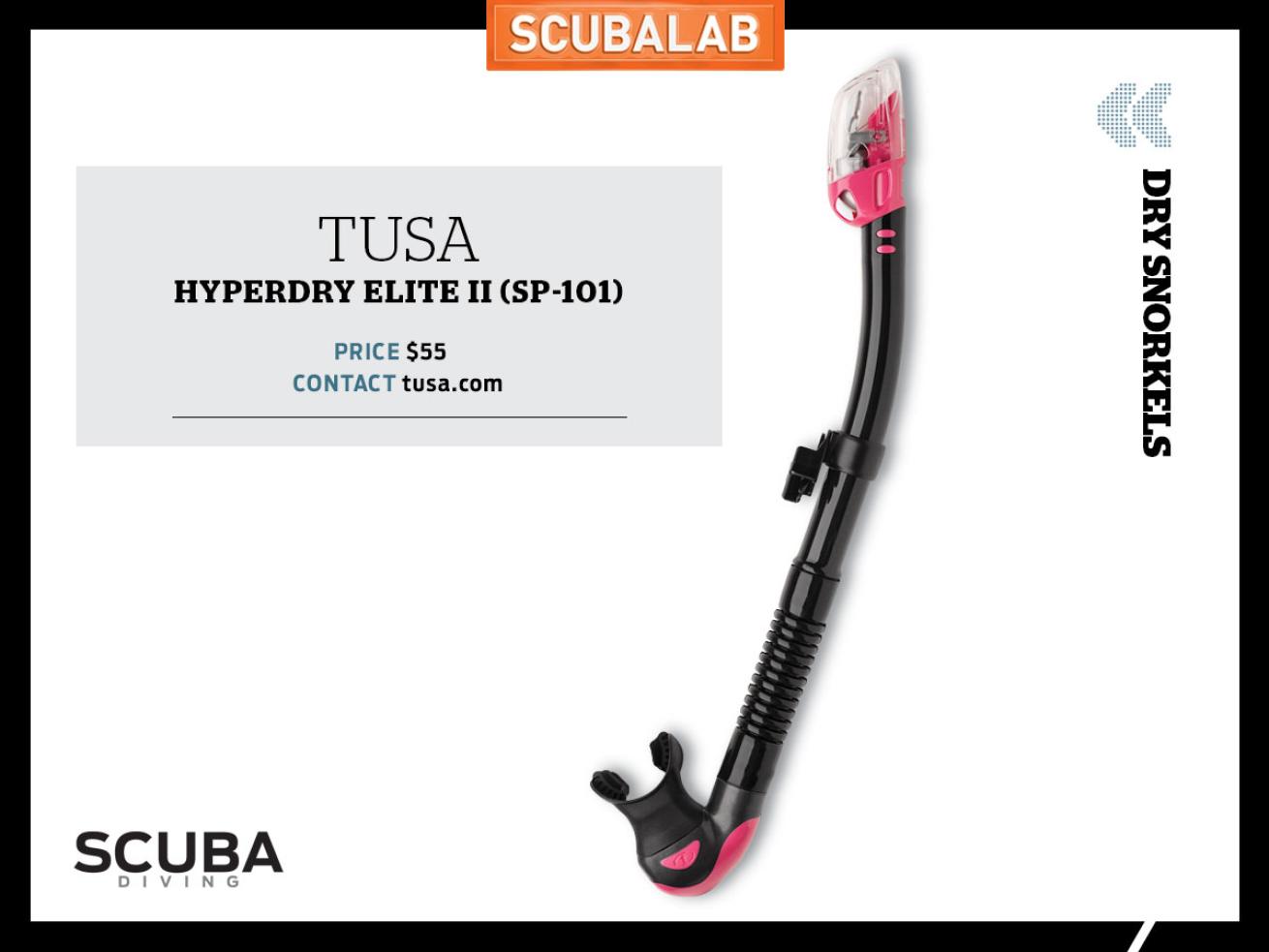
John WhittleTUSA Hyperdry Elite II (SP—0101) Snorkel
The Hyperdry has a finished look and feel, with a gracefully molded mouthpiece and smooth edges all around. With a large oval purge valve, a deep reservoir, and a smoothly operating top valve, it won very good scores for clearing and staying dry. The clear housing at the top is a nice touch; it lets you check easily for sand or weeds that can cause problems. One area where its score fell was the convenience of the mask attachment, but throughout our test, divers split on whether convenience, comfort or security was the most important criterion. Installing the Hyperdry’s retainer requires unclipping the mask strap and threading it through the retainer, which has a push-button release. Bottom line: The attachment is secure and comfortable, and — if you’re only doing it once — it’s not an inconvenience.
XS SCUBA Sedona Elite Snorkel
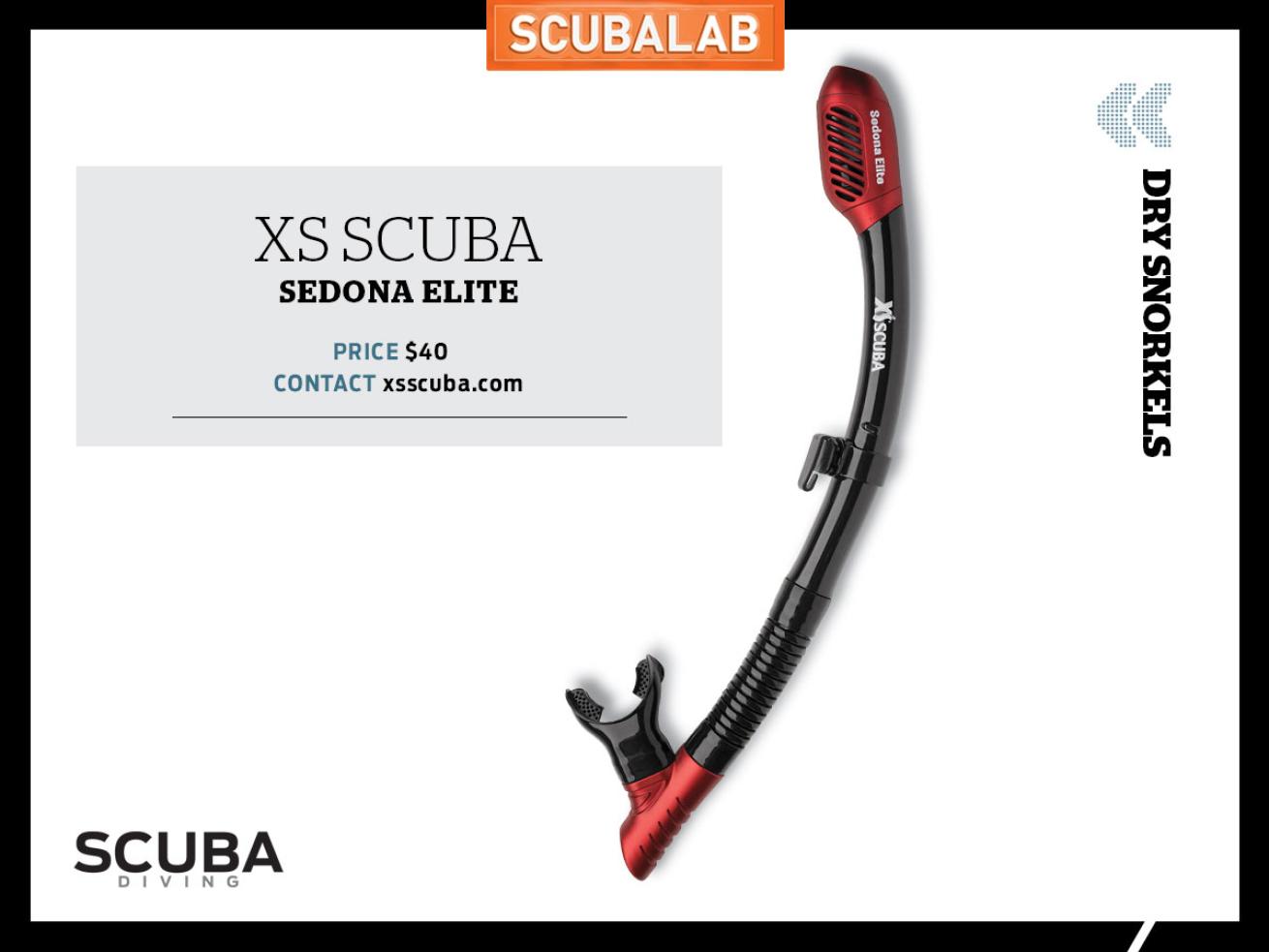
John WhittleXS SCUBA Sedona Elite Snorkel
Reminding us a little of a World War II submarine intake, the Sedona’s top valve has a housing with a slotted grill, and a simple float mechanism that seals against a silicone-padded opening at the top of the U-shaped tube. It’s pretty much a foolproof design and proved effective as well as reliable, earning the Sedona a good score from test divers for keeping water out. The top valve mechanism is a little bulkier than the others in our test, and that wide cross section, and the sizable round upper tube, had a little extra drag that sometimes translated into a bit of wobble when swimming hard. At the bottom end, the purge has a side valve at the end of the diagonal reservoir, and it earned a good rating for ease of clearing. The mask attachment has a simple push-button release that provides decent security and that divers found straightforward and simple to use.
SEAC Seaflex Snorkel
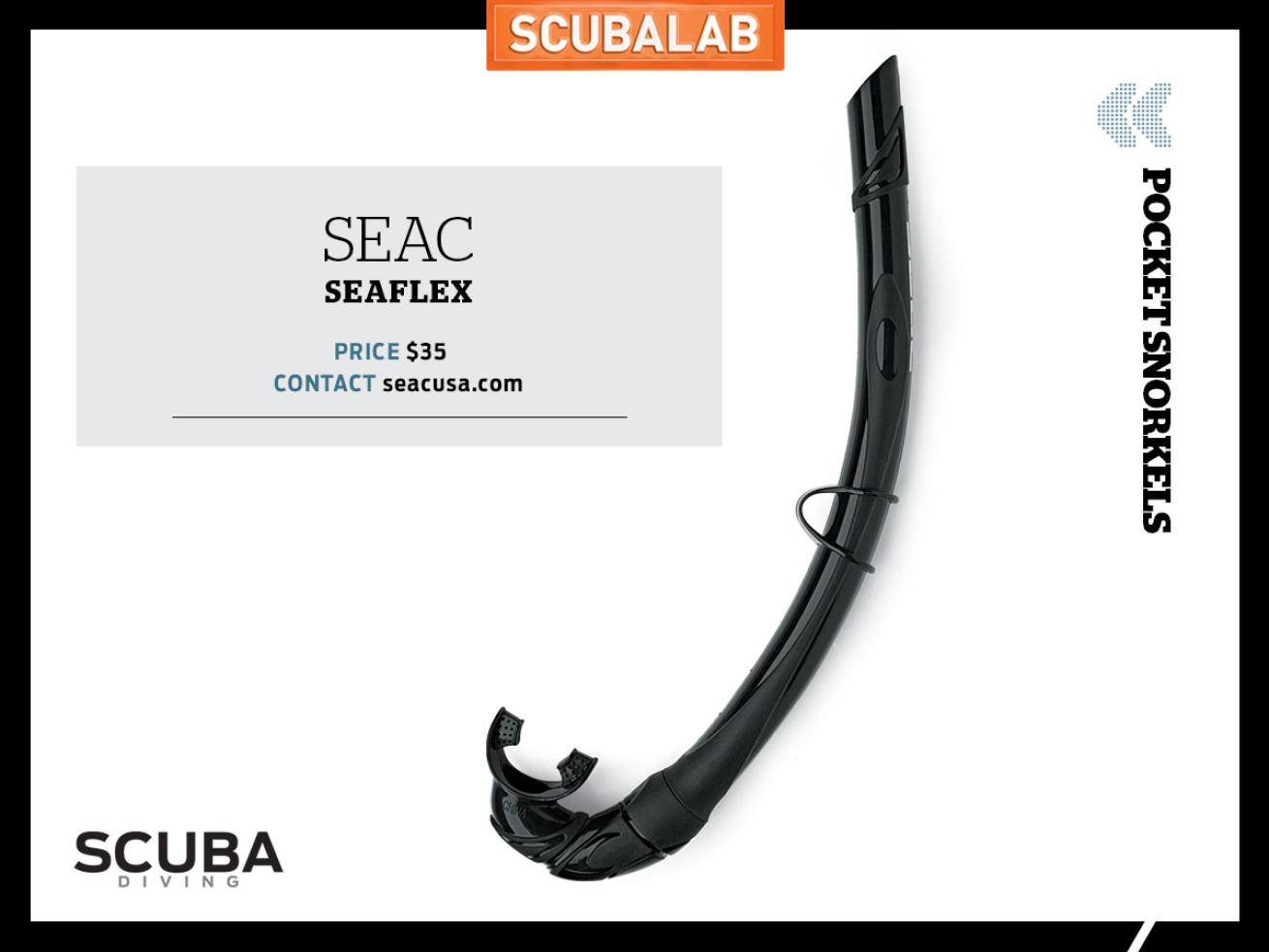
John WhittleSEAC Seaflex Snorkel
The Seaflex takes the classic J-tube snorkel shape and updates it with a flexible silicone construction that lets it roll or fold up. It comes with a nifty case about the size of a hockey puck that stows in a pocket or clips to a D-ring. The barrel of the Seaflex has slightly thicker stiffening sections at the top and bottom to help keep its shape, so there’s no excessive wobble or fluttering as you move through the water. That extra firmness also makes it easy to clear on the first try. The stretchy figure-eight-loop mask attachment is simple and secure but also means you can’t easily pull it out of your pocket when you surface and attach it to the mask. Test divers rated the Seaflex good in every evaluation category except air delivery, where it was rated very good, probably because its slightly greater length kept it a tad more above the chop while its firmer tube resisted being deformed by the wave action.
SUBGEAR Apnea Snorkel
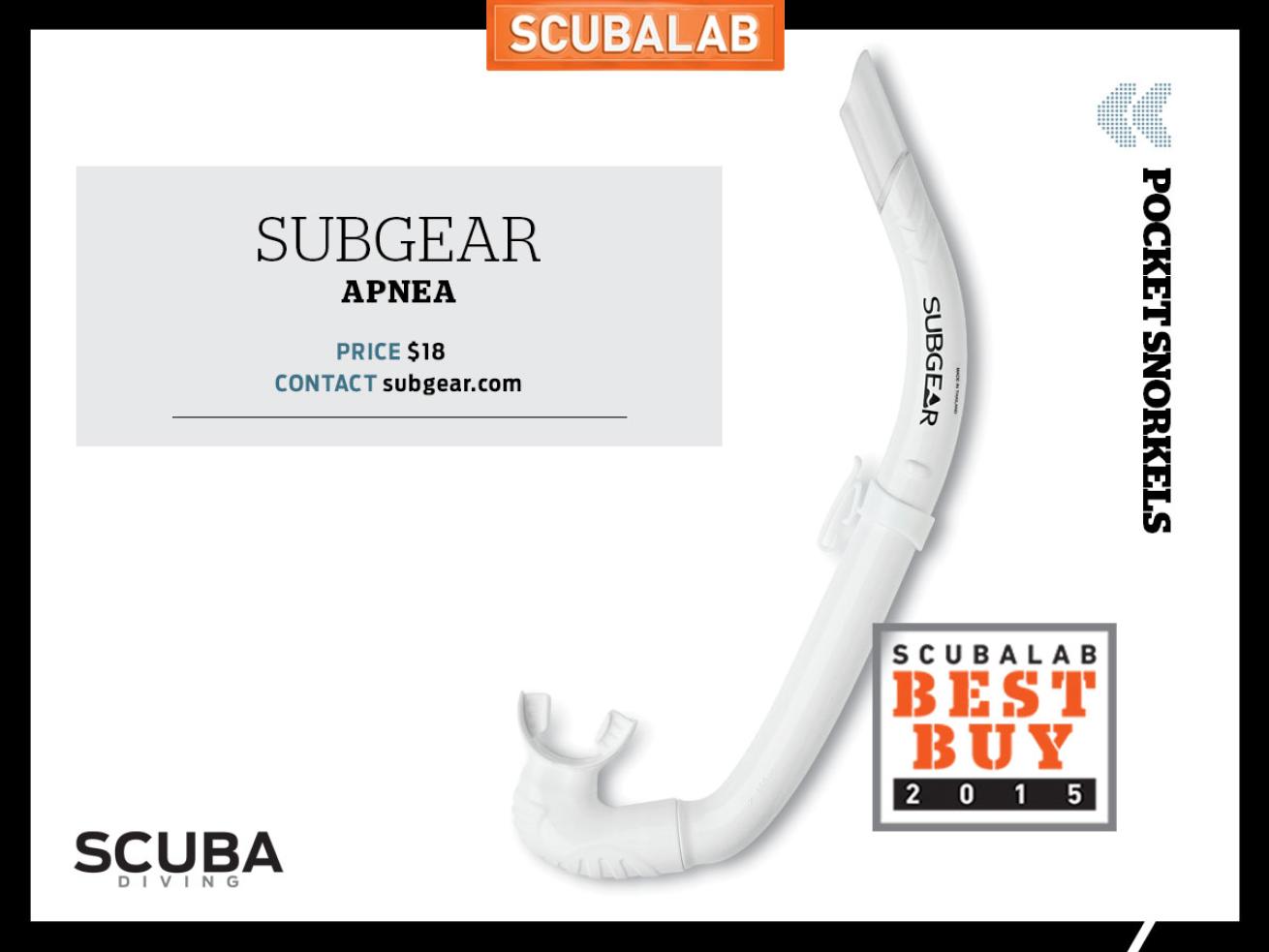
John WhittleSUBGEAR Apnea Snorkel
The soft-silicone tube and mouthpiece of the Apnea allow you to fold it up easily, and it pops back into shape when released. A hard-plastic insert at the top of the soft barrel helps keep its shape but can be removed to shorten the tube length (we kept it in; it was none too long in the chop we were snorkeling in). The one-piece mask clip isn’t made to detach from the snorkel, but with a little practice you can clip it onto the strap without removing your mask. Test divers rated the Apnea good across the board in all test categories but had a couple of quibbles. The silicone of the tube and the mouthpiece is quite soft, allowing the snorkel to wobble a bit at speed, and biting down too hard can squish the mouthpiece together. But it performed well in a stiff chop, folds easily into a BC pocket, can be clipped to a mask without removal and was still the least expensive snorkel we tested. The SubGear Apnea is our Best Buy in this category.
XS Scuba Cargo Snorkel

John WhittleXS Scuba Cargo Snorkel
A roll-up like the others here, the Cargo is unique in its details. It’s the only roll-up in our test with a purge (a valve about 5⁄8 inch in diameter) below the mouthpiece. It also has a semidry top with three holes — the larger one lines up with the tube to facilitate clearing, and the two smaller ones clip onto the mask attachment to keep it rolled up. The barrel shape is also unusual — oval, with a ridge on the leading edge that gives it a cross section like a boat. The mask attachment has a strap hook that detaches by turning 90 degrees and sliding; the arrangement isn’t so good for leaving the mask attached while on scuba, because it can pop of, but it’s easy to attach while wearing the mask. Test divers reported the Cargo sometimes took two tries to clear, but they rated it very good for mask attachment, mouthpiece design, air delivery, noise and overall comfort. The XS Scuba Cargo is our Testers Choice in this category.
Snorkels are not nearly as simple as they seem, so we tested 12 new models to see which features fit divers best during their time at the surface.
SNORKEL TEST PROTOCOLS
To evaluate the performance of each snorkel in open-water conditions, the ScubaLab team of test divers snorkeled off the beach at Sebastian Inlet State Park on Florida’s Atlantic Coast in seas of about 2 feet, with an onshore breeze of about 12 knots. Using waterproof test sheets and slates, divers rated each of the snorkels in seven performance categories, with 1 being poor performance and 5 being excellent. Divers also recorded comments about their experience using each snorkel and ranked their top three favorites in each category to find the best snorkeling gear.
The ergonomic test categories were:
» Security, adjustability, convenience and ruggedness of the mask attachment.
» Comfort, water seal and position of the mouthpiece.
» Effectiveness in blocking water entry.
» Effectiveness in removing water by the purge valve or blowing.
» Ability to supply sufficient air.
» Operating without excessive noise, such as gurgling or rattling.
» Weight, dimensions, stability (wobbling) or other factors affecting overall comfort.
The driest dry?
The snorkels in our test had a wide array of designs for dry valves (and spray guards, in the case of semidry purge models). Most of the dry tops used a pivoting valve mechanism that was activated by a float, but a couple had floats that actually served as the valve, traveling up to close of the tube opening. While divers noted differences in how well the tops kept out water, they depended more on the details of each design, rather than the type of mechanism.
Q: Are “dry” snorkels really dry?
A: Even some of our most skeptical test divers were pleasantly surprised at how dry some of these snorkels were, allowing almost no water in and purging what did enter without blowing or any conscious effort.
— Roger Roy, ScubaLab Director
NO “BEST” SNORKEL
Debating whether pocket, purge, dry or J-tube snorkels are best is like arguing whether dress or running shoes are better. For me, each in its place; a good dry snorkel for snorkeling and a pocket model for diving.
— Roger Roy, ScubaLab Director
Snorkels need love too
Make sure you give your snorkel the pre- and post-dive attention you give your other gear. Snorkels may seem like simple pieces of equipment, but some of the snorkels we tested had a dozen or more separate components. Start by checking all valves and floats to make sure they’re clean and moving freely, with no sand or other debris that could interfere with moving parts or valve diaphragms. Mask clips take a lot of abuse, so watch for signs of cracking or fatigue. Also, check for damage or leaks in the soft silicone of tubes and mouthpieces. If you have a roll-up or folding snorkel, it’s designed to handle being mashed up to squeeze into a case or your BC pocket during your dive. But when storing your pocket snorkel, remember to unroll it or pull it from its case and keep it opened up, which will help maintain its shape and prevent it from cracking.
Q: What factors did test divers find most important?
A:The snorkels that prompted diver comments like “The one I’ll buy” were able to keep out spray even on a windy, choppy day, easily purged any water they collected, were comfortable in the mouth, not too noisy, and had secure mask attachments that weren’t a pain to install.
— Roger Roy, ScubaLab Director
Noises off, please
Divers were turned off by excessive noise, usually from gurgling in the reservoir/purge valve but also whistling or rasping in the tube. Even if it didn't affect a snorkel's dryness, too much noise was annoying.

